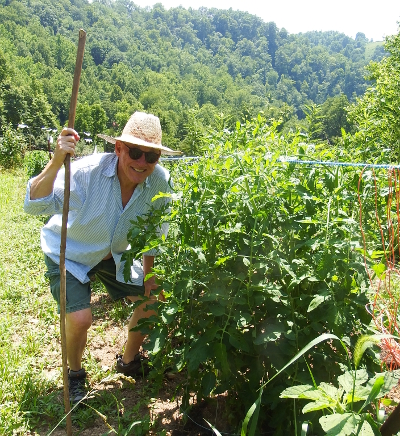
Dangers of horse manure, revisited
 Several
of you were concerned about chemical contamination in our
horse manure.
Luckily, we live in an impoverished area where excess chemicals aren't
used that often simply because they're expensive. Here's
my previous post on the topic. If our farm was located in
Lexington or northern Virginia where pastures are weed-free and
perfectly manicured, I'd be much more concerned.
Several
of you were concerned about chemical contamination in our
horse manure.
Luckily, we live in an impoverished area where excess chemicals aren't
used that often simply because they're expensive. Here's
my previous post on the topic. If our farm was located in
Lexington or northern Virginia where pastures are weed-free and
perfectly manicured, I'd be much more concerned.
That said, whenever you
find a new source of organic matter, it is
a good idea to test it out before going hog wild. Luckily, we found out
about this year's horse manure from a homesteading buddy and he got his
dump-truck load a solid month before we did. A picture is worth a
thousand words, so I'll let his tomato plants speak for themselves. In
fact, when I asked him what he thought of the fertility source, he
sounded like a born-again organic gardener. "All the years we've been
gardening," he said, "I can't imagine why we didn't add manure to the
soil!" So it sounds like
the manure isn't only safe...it's turbo-charged!
Want more in-depth information? Browse through our books.
Or explore more posts by date or by subject.
About us: Anna Hess and Mark Hamilton spent over a decade living self-sufficiently in the mountains of Virginia before moving north to start over from scratch in the foothills of Ohio. They've experimented with permaculture, no-till gardening, trailersteading, home-based microbusinesses and much more, writing about their adventures in both blogs and books.
Want to be notified when new comments are posted on this page? Click on the RSS button after you add a comment to subscribe to the comment feed, or simply check the box beside "email replies to me" while writing your comment.

Back in the 1970s, John Seymour (an Englishman, I think) wrote a book called "Guide to Self Sufficiency", of which I have a very much used and loved copy. The first page of the book says the following: "The only way that the homesteader can farm his piece of land as well and intensively as possible is to institute some variant of what was called "High Farming" in Europe in the last century. (19th Century, not 20th). Many early settlers practiced a carefully worked out balance between animals and plants, whereby each fed the other: the plants feeding the animals directly, the animals feeding the soil with their manure and the land feeding the plants."
Notice that the animals "feed" the soil with their manure. Even where I live, the dairy farmer down the road takes the manure from his cattle and plows it back into the various plots he has where he grows either grass or corn for silage.
This book is a complete how-to guide for any homesteader. I think it's been out of print since the 1980s, but if an individual is serious about homesteading, this is the manual to get if you can find it. I've used mine so much that I've actually pulled the pages apart and stuck them in plastic sheets so they would be preserved.
Hi,
It sounds like this book 'should' become a pdf?
John
I completely understand what Anna is saying- lots of folk with a few horses in the area, buying local hay which is 99% grass from fields that get little if any chemicals on them, who just give the poo away to who ever wants it.
If you need any more I can get you piles of it in Wise!
A few thoughts on manure as fertilizer: N is excreted from animal bodies via urine, not feces. Herbivorous manure contains only the little bit of N not absorbed from the low N, plant source of the feed. My compost pile, made mostly of horse manure and urine-soaked bedding, consistently tests out no better than "adequate N" on those cheapo 5-point scale test kits.
Using manure transfers nutrients from the hay plot to your garden plot but can never bring N values above "adequate." Leaving manure in the field of its origin doesn't improve the nutrient content of the field, but merely delays its degradation.
The main advantage of manure as fertilizer (particularly horse manure) is in it's physical properties: improving "carbon content" (really "fiber") in the soil. That fiber allows more small air pockets in the soil, improving moisture holding capability, better habitat for microorganisms and allowing better access of the roots to water, minerals and N.
It gets hot enough in the horse manure compost pile to turn the pine shaving bedding to ash. I use that compost to start seeds indoors each year resulting in great germination rates and have no problems with volunteer weeds or fungus.